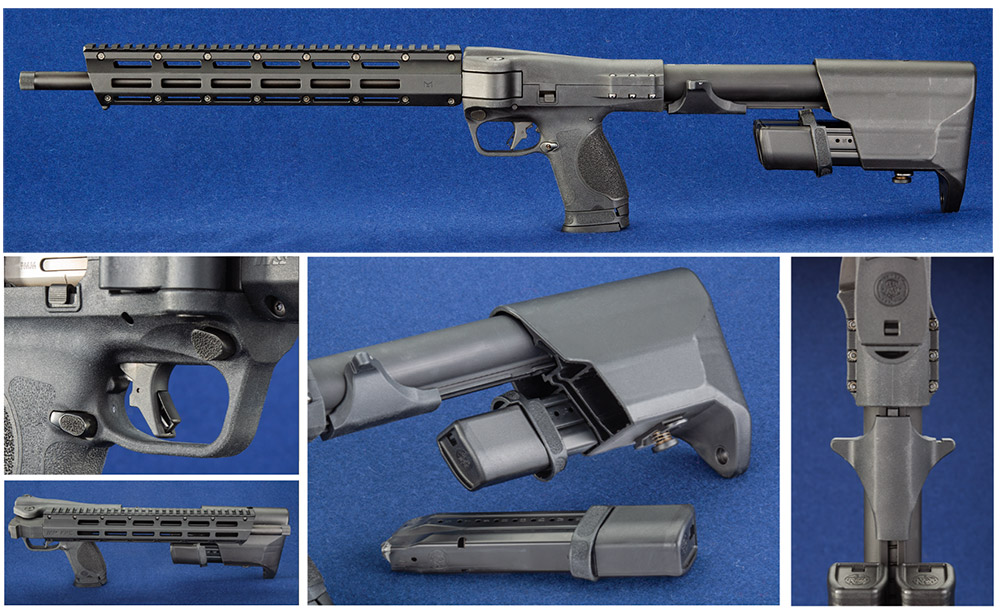
When I first saw the Smith & Wesson M&P FPC (Folding Pistol Carbine), it seemed like a gimmick; after all, how could a carbine that folds between the receiver and barrel achieve decent accuracy? And what would such a gun be good for, anyway?
After a little more thought, I realized there were lots of good answers to the second question, ranging from self-defense to plinking to competition to survival applications. So, I decided to see for myself what S&W had created.
Chambered in 9 mm, the FPC is a blowback semi-automatic that, when unfolded, measures 30.4 inches—a diminutive carbine. When folded, some measure of concealability is within reach, at least within a vehicle or backpack.
The gun features an aluminum receiver encasing a stainless-steel bolt and carrier. A pistol grip protrudes from the underside. Those familiar with S&W’s popular family of M&P pistols will immediately recognize that is has the same grip. And, yes, magazines load into the grip just like they do with the pistols. Conveniently, the grip accepts the same magazines as used with the M&P 9 pistol, and the FPC comes with two 23-round mags and one 17-rounder. Like the pistols, it also utilizes varying sized palm-swell inserts so that it can be modified to fit anyone.
A set of “ears,” which act as a charging handle, are found behind the chamber. This mechanism also holds the barrel and handguard in place when the gun is folded. The wide, flat-faced trigger features an inset safety, and there’s also a manual safety located just in front of the trigger guard. Magazines are dropped with a reversible magazine release in the same spot as on the M&P pistol.

Rounding out the back half of the gun, the polymer buttstock features in-stock magazine storage that can hold two magazines, which are easily accessed with a quick-release tab system.
The FPC swivels, or folds, just in front of the receiver. It locks firmly in place, but it can easily and quickly be folded with the quick-release latch located in front of the right-side ejection port. The 16.25-inch barrel is enclosed by a handguard that features a full Picatinny rail with M-Lok slots, and the barrel is threaded so that a suppressor can be attached.
The gun comes in a handy carry bag with storage slots and hook-and-loop fasteners to hold it in place, in which you’ll find the three magazines and four grip inserts previously mentioned.
 Upon unfolding the gun and locking the handguard and barrel into place, it locked up tightly with no play between the two sections. I thought perhaps it would be a shooter after all.
Upon unfolding the gun and locking the handguard and barrel into place, it locked up tightly with no play between the two sections. I thought perhaps it would be a shooter after all.
The FPC doesn’t come with sights, but from the first time I saw it, I knew exactly what to use for a sighting solution. Aimpoint’s CompM5s red dot is small, fast and high-quality. These are designed for shooting with both eyes open, which is handy in a self-defense situation, and they allow for unlimited eye relief—great for the far-forward rail on the FPC. Sure, using a high-powered scope would have helped wring out maximum accuracy, but that’s not what the gun was made for and would render it heavier and more cumbersome.
Mounted, the CompM5s did not affect the folding of the gun—or vice-versa—and it made the FPC even more attractive. I couldn’t wait to get it to the range.
For testing, I settled on running one FMJ load and two different self-defense loads.
It’s important to note the FPC had many factors working against it. First, at 50 yards and with no magnification, the 2-MOA dot completely covered the 1-inch aiming points, making precise aiming difficult. Add in a pair of 61-year-old eyes, and I didn’t expect much. And indeed, the range rounds didn’t impress … but when the self-defense loads began flying, things began to look up. Five-shot groups were measuring well under two inches, and several would have been under one inch if not for a flyer here or there. Noticeably, the gun didn’t fail to feed, fire, eject or lock back on the last round, all important traits in a self-defense firearm.
And, man, is it fun to shoot!
After shooting groups and doing some rapid-fire and double-taps on 50-yard targets, my eyes wandered to a two-foot-by-two-foot piece of steel set at 200 yards. Taking aim with a rest and the least-accurate ammo, I sent 10 rounds downrange and, as I was unable to figure the correct holdover, I only managed to connect once. Another shooter offered to spot for me and finally walked me in, enabling me to hit three of my last five 200-yard shots.
The final test was to see whether the folded FPC would fit in the console of my pick-up. I was disappointed when it wouldn’t immediately fit, but I quickly figured out how to remove the console’s top tray and the shelves holding it, whereupon I found it easy to insert the gun and remove it without banging it around. Having 63 rounds of 9 mm at your disposal—in a long-gun package, at that—far outweighs any inconvenience.
In the end, the FPC doesn’t exhibit rifle-like precision—at least it didn’t for me—but it’s a much easier platform for me to put 9 mm rounds on target from a few feet to 100 yards or so than a pistol is. As to what it’s good for, I’d say just about anything you can use a PCC for, from self-defense to home-protection to plinking. I believe it would also make a great truck gun, and for RVers who want the protection of a long gun in an easily stowable package, it might be hard to beat.


































